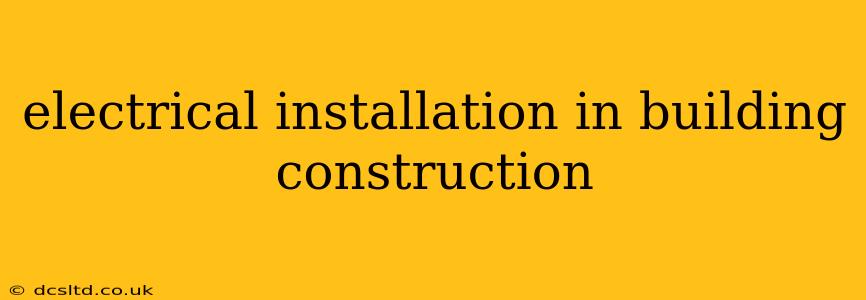Electrical installation is a critical aspect of building construction, ensuring the safety and functionality of the structure. From the initial planning stages to the final inspections, a meticulous and code-compliant approach is paramount. This comprehensive guide delves into the intricacies of electrical installation in building construction, addressing key considerations for both residential and commercial projects.
What are the key stages involved in electrical installation during building construction?
The electrical installation process in building construction typically involves several key stages:
-
Design & Planning: This initial phase involves collaborating with architects and engineers to determine the building's electrical needs. This includes mapping out lighting layouts, power outlets, circuits, and the overall electrical system's capacity. Detailed schematics and plans are created to guide the subsequent installation phases.
-
Material Procurement: Once the design is finalized, the necessary materials are procured. This includes wiring, conduits, junction boxes, circuit breakers, switches, outlets, and other electrical components. Careful selection of high-quality, code-compliant materials is essential for safety and longevity.
-
Rough-In: This is the phase where the main electrical infrastructure is installed. This involves running conduits (protective tubes for wiring) through walls, floors, and ceilings, installing junction boxes, and pulling the necessary wiring. Accurate and careful work during this stage is crucial to avoid future complications.
-
Inspection: Before proceeding to the next phase, a thorough inspection is typically conducted by a qualified inspector to ensure the rough-in work conforms to all relevant building codes and safety standards.
-
Finishing: This involves installing the final electrical components such as switches, outlets, light fixtures, and any other required equipment. This stage requires attention to detail and adherence to aesthetic considerations.
-
Testing & Commissioning: Once the installation is complete, rigorous testing is performed to ensure the system's functionality and safety. This involves checking for proper grounding, voltage levels, and circuit integrity.
-
Final Inspection: A final inspection by the relevant authority is conducted to verify compliance with all building codes and regulations before the building can be occupied.
What are the different types of electrical wiring used in building construction?
Several types of electrical wiring are commonly used in building construction, each with its own advantages and disadvantages:
-
Copper Wiring: This is the most common type, known for its excellent conductivity and durability. It's suitable for various applications, from residential to commercial settings.
-
Aluminum Wiring: While less common than copper due to its higher risk of overheating and corrosion, aluminum wiring is still used in some applications, often requiring specific installation techniques and precautions.
-
Non-Metallic Sheathed Cable (NM-B or Romex): This is a common type of wiring for residential construction. It's easy to install and relatively inexpensive.
-
Metal-Clad Cable (BX): This type of wiring offers better protection against physical damage than NM-B. It's often used in areas where there's a higher risk of mechanical impact.
What are the safety regulations and codes for electrical installations in buildings?
Electrical installations must adhere to strict safety regulations and codes, varying slightly by location. Generally, these codes aim to minimize the risk of electrical shocks, fires, and other hazards. Compliance with these codes is not just a matter of best practice; it's often a legal requirement. Examples include the National Electrical Code (NEC) in the United States and similar standards in other countries. These codes cover aspects like grounding, overcurrent protection, wiring methods, and equipment installation.
What are some common electrical problems in buildings and how to fix them?
Common electrical problems include:
-
Tripped Circuit Breakers: This indicates an overloaded circuit. Unplug unnecessary appliances or redistribute the load among different circuits.
-
Flickering Lights: This could be due to loose connections, faulty wiring, or insufficient capacity. A qualified electrician should investigate the cause.
-
Outlet Malfunctions: This can result from loose connections, damaged outlets, or overloaded circuits.
-
Shocks: This is a serious safety hazard that indicates a grounding problem or faulty wiring. Immediate professional attention is required.
Addressing these problems usually requires the expertise of a licensed electrician. Attempting DIY repairs on electrical systems can be dangerous and should be avoided unless you have the necessary qualifications and experience.
How much does electrical installation cost in building construction?
The cost of electrical installation varies significantly based on factors such as the building's size, complexity, the type of materials used, and the location. It's essential to obtain detailed quotes from multiple qualified electricians to compare pricing and scope of work.
This guide provides a general overview of electrical installation in building construction. For specific project requirements and detailed information, always consult with qualified professionals and refer to the relevant building codes and regulations in your area. Remember, safety should always be the top priority when dealing with electrical systems.
